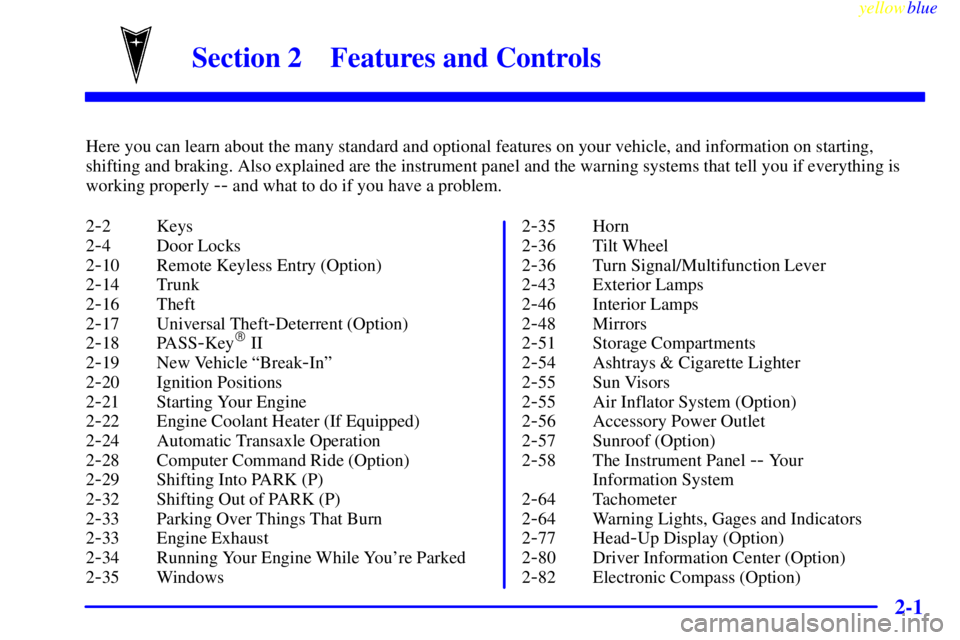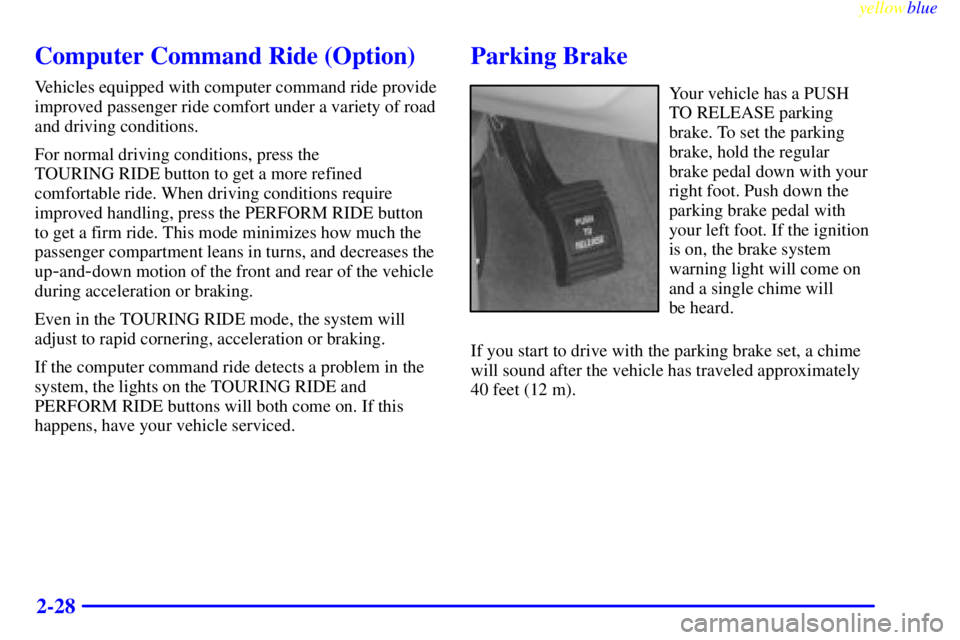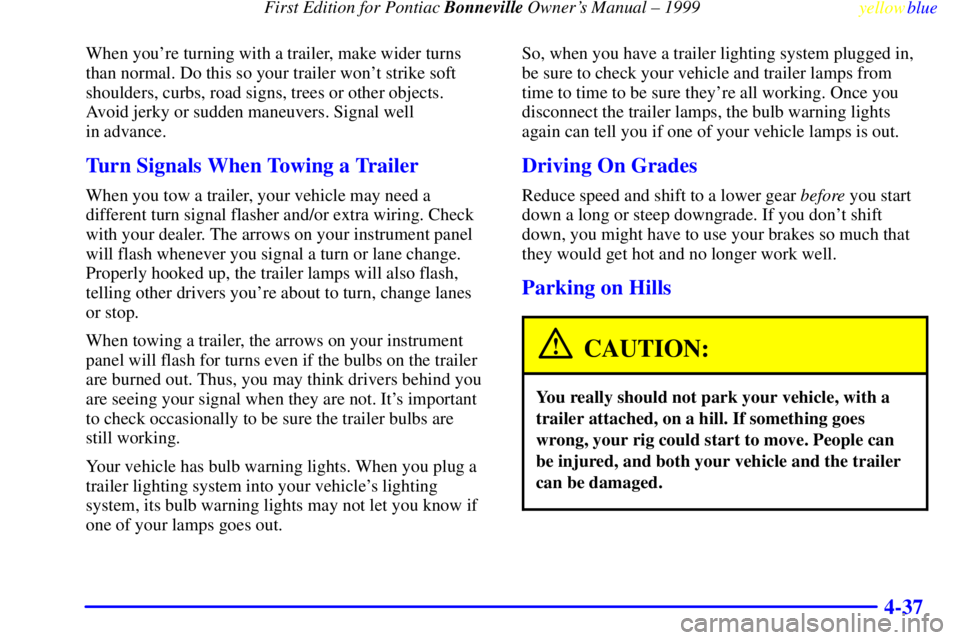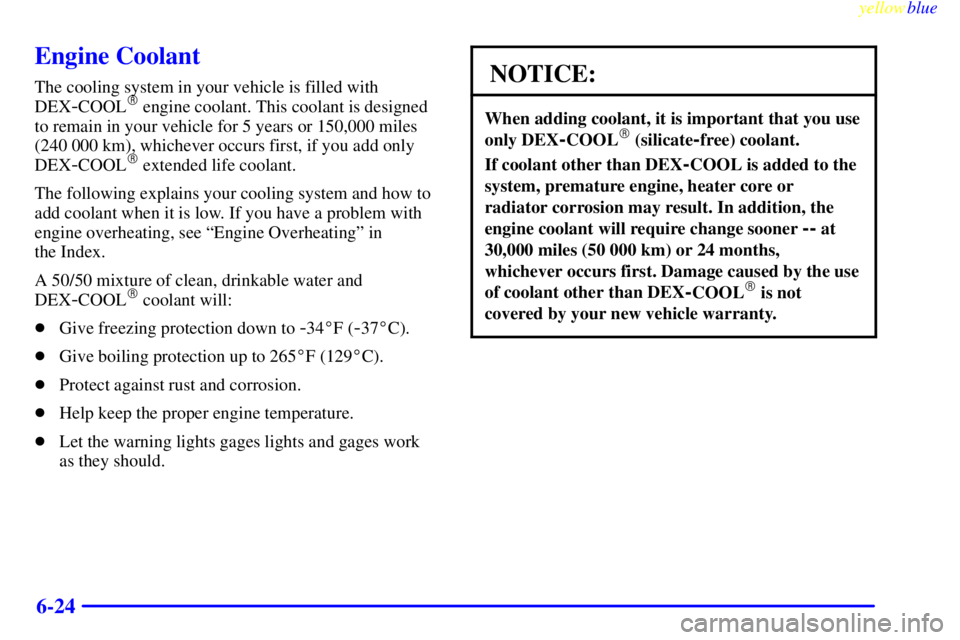Page 5 of 392

First Edition for Pontiac Bonneville Owner's Manual ± 1999
yellowblue
v
For example,
these symbols
are used on an
original battery:
CAUTION
POSSIBLE
INJURY
PROTECT
EYES BY
SHIELDING
CAUSTIC
BATTERY
ACID COULD
CAUSE
BURNS
AVOID
SPARKS OR
FLAMES
SPARK OR
FLAME
COULD
EXPLODE
BATTERY
These symbols
are important
for you and
your passengers
whenever your
vehicle is
driven:
DOOR LOCK
UNLOCK
FASTEN
SEAT
BELTS
POWER
WINDOW
AIR BAG
These symbols
have to do with
your lamps:
MASTER
LIGHTING
SWITCH
TURN
SIGNALS
PARKING
LAMPS
HAZARD
WARNING
FLASHER
DAYTIME
RUNNING
LAMPS
FOG LAMPS
These symbols
are on some of
your controls:
WINDSHIELD
WIPER
WINDSHIELD
WASHER
WINDSHIELD
DEFROSTER
REAR
WINDOW
DEFOGGER
VENTILATING
FAN
These symbols
are used on
warning and
indicator lights:
ENGINE
COOLANT
TEMP
BATTERY
CHARGING
SYSTEM
BRAKE
COOLANT
ENGINE OIL
PRESSURE
ANTI-LOCK
BRAKES
Here are some
other symbols
you may see:
FUSE
LIGHTER
HORN
SPEAKER
FUEL
Vehicle Symbols
These are some of the symbols you may find on your vehicle.
Page 61 of 392

2-
yellowblue
2-1
Section 2 Features and Controls
Here you can learn about the many standard and optional features on your vehicle, and information on starting,
shifting and braking. Also explained are the instrument panel and the warning systems that tell you if everything is
working properly
-- and what to do if you have a problem.
2
-2 Keys
2
-4 Door Locks
2
-10 Remote Keyless Entry (Option)
2
-14 Trunk
2
-16 Theft
2
-17 Universal Theft-Deterrent (Option)
2
-18 PASS-Key� II
2
-19 New Vehicle ªBreak-Inº
2
-20 Ignition Positions
2
-21 Starting Your Engine
2
-22 Engine Coolant Heater (If Equipped)
2
-24 Automatic Transaxle Operation
2
-28 Computer Command Ride (Option)
2
-29 Shifting Into PARK (P)
2
-32 Shifting Out of PARK (P)
2
-33 Parking Over Things That Burn
2
-33 Engine Exhaust
2
-34 Running Your Engine While You're Parked
2
-35 Windows2
-35 Horn
2
-36 Tilt Wheel
2
-36 Turn Signal/Multifunction Lever
2
-43 Exterior Lamps
2
-46 Interior Lamps
2
-48 Mirrors
2
-51 Storage Compartments
2
-54 Ashtrays & Cigarette Lighter
2
-55 Sun Visors
2
-55 Air Inflator System (Option)
2
-56 Accessory Power Outlet
2
-57 Sunroof (Option)
2
-58 The Instrument Panel -- Your
Information System
2
-64 Tachometer
2
-64 Warning Lights, Gages and Indicators
2
-77 Head-Up Display (Option)
2
-80 Driver Information Center (Option)
2
-82 Electronic Compass (Option)
Page 88 of 392

yellowblue
2-28
Computer Command Ride (Option)
Vehicles equipped with computer command ride provide
improved passenger ride comfort under a variety of road
and driving conditions.
For normal driving conditions, press the
TOURING RIDE button to get a more refined
comfortable ride. When driving conditions require
improved handling, press the PERFORM RIDE button
to get a firm ride. This mode minimizes how much the
passenger compartment leans in turns, and decreases the
up
-and-down motion of the front and rear of the vehicle
during acceleration or braking.
Even in the TOURING RIDE mode, the system will
adjust to rapid cornering, acceleration or braking.
If the computer command ride detects a problem in the
system, the lights on the TOURING RIDE and
PERFORM RIDE buttons will both come on. If this
happens, have your vehicle serviced.
Parking Brake
Your vehicle has a PUSH
TO RELEASE parking
brake. To set the parking
brake, hold the regular
brake pedal down with your
right foot. Push down the
parking brake pedal with
your left foot. If the ignition
is on, the brake system
warning light will come on
and a single chime will
be heard.
If you start to drive with the parking brake set, a chime
will sound after the vehicle has traveled approximately
40 feet (12 m).
Page 120 of 392
yellowblue
2-60
Instrument Panel Clusters
Your instrument panel clusters are designed to let you know at a glance how your vehicle is running. You'll know how
fast you're going, how much fuel you're using, and many other things you'll need to drive safely and economically.
Your vehicle is equipped with one of these instrument panel clusters, which includes indicator warning lights and
gages that are explained on the following pages.
Cluster with Gages
Page 124 of 392

yellowblue
2-64
Tachometer
The tachometer shows your
engine speed in revolutions
per minute (rpm). Do not
run your engine at speeds in
the red area.
Warning Lights, Gages
and Indicators
This part describes the warning lights and gages that
may be on your vehicle. The pictures will help you
locate them.
Warning lights and gages can signal that something is
wrong before it becomes serious enough to cause an
expensive repair or replacement. Paying attention to
your warning lights and gages could also save you or
others from injury.Warning lights come on when there may be or is a
problem with one of your vehicle's functions. As you
will see in the details on the next few pages, some
warning lights come on briefly when you start the
engine just to let you know they're working. If you are
familiar with this section, you should not be alarmed
when this happens.
Gages can indicate when there may be or is a problem
with one of your vehicle's functions. Often gages and
warning lights work together to let you know when
there's a problem with your vehicle.
When one of the warning lights comes on and stays on
when you are driving, or when one of the gages shows
there may be a problem, check the section that tells you
what to do about it. Please follow this manual's advice.
Waiting to do repairs can be costly -- and even
dangerous. So please get to know your warning lights
and gages. They're a big help.
Your vehicle may also have a driver information system
that works along with the warning lights and gages.
See ªDriver Information Systemº in the Index.
Page 136 of 392
yellowblue
2-76 Systems Monitor (Option)
If you have the Systems
Monitor, it gives you
important safety and
maintenance facts.
When you turn the ignition on, the Systems Monitor and
warning lights will briefly light up. If a problem is
detected, the warning lights will turn on.The following warning lights are displayed in the
Systems Monitor:
�Check Oil Level: This message could mean your oil
level is low. If it comes on for more than three
seconds, see ªCheck Oil Level Warning Lightº in
the Index.
�Washer Fluid: This message means your washer
fluid tank is less than about 30 percent full. If this
light comes on, see ªWindshield Washer Fluidº in
the Index.
�Check Doors: This message means that either the
driver's door or one of the passenger's doors is not
completely closed. If this light comes on, see ªCheck
Doors Lightº in the Index.
�Brake: If this message comes on while you are
driving, it means there is a brake problem. See
ªBrake System Warning Lightº in the Index.
Page 215 of 392

First Edition for Pontiac Bonneville Owner's Manual ± 1999
yellowblue
4-37
When you're turning with a trailer, make wider turns
than normal. Do this so your trailer won't strike soft
shoulders, curbs, road signs, trees or other objects.
Avoid jerky or sudden maneuvers. Signal well
in advance.
Turn Signals When Towing a Trailer
When you tow a trailer, your vehicle may need a
different turn signal flasher and/or extra wiring. Check
with your dealer. The arrows on your instrument panel
will flash whenever you signal a turn or lane change.
Properly hooked up, the trailer lamps will also flash,
telling other drivers you're about to turn, change lanes
or stop.
When towing a trailer, the arrows on your instrument
panel will flash for turns even if the bulbs on the trailer
are burned out. Thus, you may think drivers behind you
are seeing your signal when they are not. It's important
to check occasionally to be sure the trailer bulbs are
still working.
Your vehicle has bulb warning lights. When you plug a
trailer lighting system into your vehicle's lighting
system, its bulb warning lights may not let you know if
one of your lamps goes out. So, when you have a trailer lighting system plugged in,
be sure to check your vehicle and trailer lamps from
time to time to be sure they're all working. Once you
disconnect the trailer lamps, the bulb warning lights
again can tell you if one of your vehicle lamps is out.
Driving On Grades
Reduce speed and shift to a lower gear before you start
down a long or steep downgrade. If you don't shift
down, you might have to use your brakes so much that
they would get hot and no longer work well.
Parking on Hills
CAUTION:
You really should not park your vehicle, with a
trailer attached, on a hill. If something goes
wrong, your rig could start to move. People can
be injured, and both your vehicle and the trailer
can be damaged.
Page 274 of 392

yellowblue
6-24
Engine Coolant
The cooling system in your vehicle is filled with
DEX
-COOL� engine coolant. This coolant is designed
to remain in your vehicle for 5 years or 150,000 miles
(240 000 km), whichever occurs first, if you add only
DEX
-COOL� extended life coolant.
The following explains your cooling system and how to
add coolant when it is low. If you have a problem with
engine overheating, see ªEngine Overheatingº in
the Index.
A 50/50 mixture of clean, drinkable water and
DEX
-COOL� coolant will:
�Give freezing protection down to
-34�F (-37�C).
�Give boiling protection up to 265�F (129�C).
�Protect against rust and corrosion.
�Help keep the proper engine temperature.
�Let the warning lights gages lights and gages work
as they should.
NOTICE:
When adding coolant, it is important that you use
only DEX
-COOL� (silicate-free) coolant.
If coolant other than DEX-COOL is added to the
system, premature engine, heater core or
radiator corrosion may result. In addition, the
engine coolant will require change sooner
-- at
30,000 miles (50 000 km) or 24 months,
whichever occurs first. Damage caused by the use
of coolant other than DEX
-COOL� is not
covered by your new vehicle warranty.